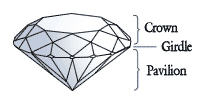Cut |
|
Cut is the most overlooked
of the Four Cs of Diamond quality, and is very important as it
effects a Diamond's beauty and value. A finer cut gives a Diamond
more brilliance, which to the consumer is what a Diamond is really
all about.
|

The particular angles and finish of any Diamond
are what determine its ability to reflect light, which in turn,
leads to brilliance. Various factors regarding cut are considered.
The consumer frequently confuses a Diamond's
shape with its cut, most likely due to the industry's synonymous
use of the term cut to describe a Diamonds shape (marquise cut,
pear shape). When we refer to the cut of a Diamond, we are really
referring to a compilation of two factors - its proportions in
terms of angles degrees and percentages, and the qualities of
its finish.

Viewing from left to right: A shallow cut,
A good cut, An ideal cut
|
|
Proportion:
A well cut Diamond reflects light back to the eye evenly
and very brightly, with no dark areas. As the diagram above
illustrates, when a Diamond is properly proportioned and
well-cut, light enters through the table and travels all
the way to the pavilion (bottom half) where it reflects
from one side to the other - intensifying in the mirror-like
facets as it travels - before reflecting back out of the
Diamond through the crown (top half) and to the observer's
eye. |
 |
Finish:
Finish refers to the surface qualities given to a Diamond
by the Diamond cutter. The term finish covers every aspect
of a Diamond's appearance that is not a result of the intrinsic
nature of the Diamond (when it comes out of the ground).
When viewing a grading report, you will note that its finish
is actually broken-down into two categories: Polish and
Symmetry. |
 |
Polish:
Polish refers to the overall surface "finish"
of a Diamond. The quality of the polish of a Diamond affects
the ability of light to reflect from its facets.
Cutters sometimes encounter variations in hardness, or
grain, as they polish a Diamond. This often results in
microscopic polish lines running across a facet. These
grain lines result in a lower rating for polish on a certificate,
but rarely is the polish of Diamond so bad that it mars
the beauty of a Diamond. Examples of blemishes that might
be considered 'polish' characteristics are faint polishing
lines and small surface nicks or scratches.
|
 |
Symmetry:
Symmetry refers to the consistency of facet shape and
how well the points of each facet align with each other.
The actual shape and proportions of a Diamond are not
considered when a Diamond is graded for symmetry.
A Diamond can have extremely poor proportions and still
be rated as Very Good in symmetry if its facets are equal
and the overall shape of the Diamond is balanced. Some
of the more common symmetry faults that Diamond graders
look for are, round-brilliant Diamonds that are "out-of-round",
facets that are out of alignment, facet points that do
not meet and an off-center table.
|
|
| |
For Colored Gemstones the CUT grade is the
third most important factor for evaluating colored gemstones.
However, cut can positively or adversely affect the color grade
of a gemstone as well. In addition, designer cut colored gemstones
will add a premium to the overall value. Proportions taken in
account are as follows: Outline balance, length to width ratio,
profile balance, total depth percentage, crown height and pavilion
depth, bulge, table size and brilliance. Keep in mind that most
colored gemstones, rough yield is the primary factor in cut. Colored
gemstone cutters try to get the largest finished gemstone possible
from every piece of rough material.
|
|
Extra Fine:
Excellent proportions and finish, length to width ratio
in preferred range, table size and girdle thickness in preferred
range, polish and symmetry very good to excellent. |
 |
Fine:
Very good proportions and finish, length to width ratio should
still be in preferred range or very close to it, table size
and girdle thickness close to preferred range, polish and
symmetry good to very good. |
 |
Good:
Good proportions and finish, length to width ratio may be
out of preferred range, table and girde may be out of preferred
range, polish and symmetry fair to good. |
 |
Fair:
Poor to fair proportions and finish, length to width ratio
undesirable, obviously large table and girdle, polish and
symmetry poor to fair.
|
|
| |
Like the rest of the Four Cs, the influence of
cut on value is directly related to its rarity.
As you read about other THREE of the Four Cs (Carat, Color &
Clarity), you will see how cut plays an important role in Diamond
and Colored Gemstone certification. |
| |
 |
|